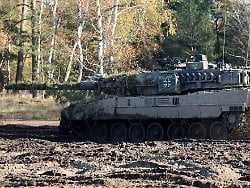Thursday, January 13, 2022
Ministry submits report
Three out of four weapon systems are operational
Frigates, tanks and helicopters are among the main weapon systems. According to a report by the Ministry of Defense, 77 percent of them are currently operational, one percentage point more than last year. The problem child, however, are the helicopters – only one in four of them can take off carefree.
According to figures from the Defense Ministry, 77 percent of the main weapon systems in the units of the Bundeswehr are operational. The ministry announced that the rate “stabilized” after 76 percent in May of last year. The so-called main weapon systems include frigates, helicopters and tanks. “The Bundeswehr is able to perform its tasks at short notice, flexibly and together with our allies inside and outside Germany”, assured Inspector General Eberhard Zorn.
At the same time, the Bundeswehr spent significantly more money on weapons and equipment. “All in all, the scope of the armaments industry rose to around 18.3 billion euros in 2021. That is 1.5 billion euros more than in the previous year,” said the report. 8.7 billion euros were therefore accounted for by military procurements by the responsible federal office BAAINBw. The repair of its equipment pool cost the Bundeswehr 4.5 billion euros. The operational readiness of all 71 major weapon systems has improved slightly, the report said. “Our target of 70 percent average material operational readiness exceeded 38 main weapon systems, 11 were below 50 percent (including 6 legacy systems).”
Every third Puma tank is not operational
The helicopters come in last, of which only 40 percent are operational. The ministry writes of a “too low, unsatisfactory level”. The reason for “complex” helicopters such as the NH 90 or the Tiger combat helicopter is time-consuming maintenance and inspection systems and retrofitting. At the same time, the operational flight operations of “old” helicopters can only be maintained at great expense and with great effort due to the age-related susceptibility to failure and a difficult spare parts situation. In the case of the Puma infantry fighting vehicle, a problem in recent years, the ministry is making “visible progress”. The operational readiness could be increased by an average of 65 percent (plus 11 percentage points) – but that also means that, as a rule, every third Puma was not operational.
There is a secret part of the report that, following an earlier decision, will not be published. In the past, the opposition had also questioned the actual meaningfulness of the total figures, for which the very differently sized systems from the frigate to the brand-new truck are weighted. The Ministry of Defense has been accused of fine-tuning the numbers.
The Bundeswehr figures refer to the existing and available stock in the force, 70 percent of which should be ready for use. “The degree of material operational readiness of the main weapon systems results from the ratio of the operational stock to the available stock,” it says. The larger total inventory, however, also includes devices and weapons that have been given for repair or that have been converted to new technology.
